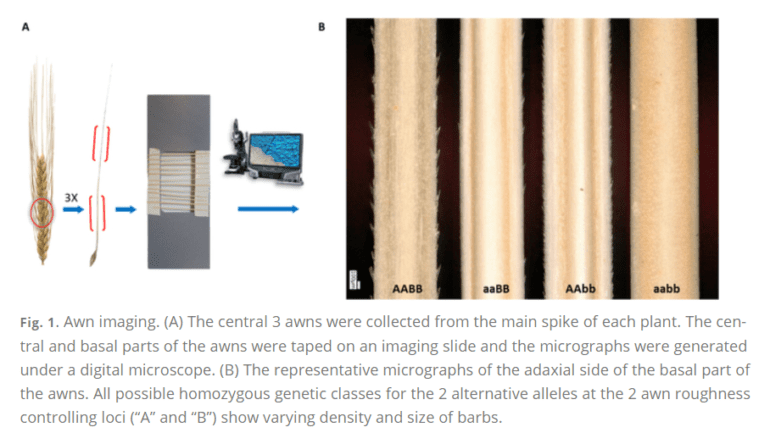TL;DR:
- BarbNet, a specialized deep learning model, is designed to automate the detection and phenotyping of barbs in microscopic images of awns, crucial components of grain crops like wheat and barley.
- Awns serve multiple functions, including protection, seed dispersal, and photosynthesis, and their barbs are essential yet challenging to analyze.
- Researchers refined BarbNet’s architecture, incorporating batch normalization, adjusting kernel sizes, and modifying model depth to assess various barb characteristics.
- Traditional methods like scanning electron microscopy were less efficient for high-throughput analysis, prompting the development of BarbNet.
- BarbNet achieved a 90% accuracy rate in detecting diverse awn phenotypes but faces challenges with tiny barbs and densely packed ones.
- To enhance precision and adaptability, researchers suggest expanding the training set and exploring alternative convolutional neural network models.
- The model was trained using binary cross-entropy loss and Dice Coefficient, achieving a validation score of 0.91.
- A comparative study demonstrated an 86% concordance rate between BarbNet predictions and manual annotations.
- BarbNet also aids in classifying awn phenotypes based on genotype, shedding light on genetic factors governing barb development.
Main AI News:
In the realm of agriculture, where the foundations of our daily sustenance rest upon the growth of grain crops like wheat and barley, the intricate understanding of their phenotypic traits is paramount. Central to these crops are their awns, bristle-like extensions with multifaceted roles encompassing protection, seed dispersal, and photosynthesis. The awns conceal a hidden secret: barbs, minuscule hook-like structures adorning their surface. While the significance of these barbs is indisputable, their detailed analysis has long been hindered by the absence of automated tools.
Enter BarbNet, a groundbreaking deep-learning model meticulously crafted to cater to the precise needs of automated barb detection and phenotyping in microscopic images of awns. Pioneered by adept researchers in the domain of Plant Phenomics, BarbNet has embarked on a journey to transform the way we perceive and analyze these vital components of grain crops.
To develop BarbNet, the research team embarked on a comprehensive journey, training and validating the model with a curated dataset encompassing 348 diverse images representing a multitude of awn phenotypes, replete with varying barb sizes and densities. The foundation of BarbNet lies in the refinement of the U-net architecture, marked by strategic enhancements such as batch normalization, the strategic omission of dropout layers, augmented kernel sizes, and judicious adjustments in model depth. These intricacies empower BarbNet to delve deep into assessing myriad characteristics, from barb size, shape, and orientation to the identification of additional features like glandular structures and pigment distribution.
Traditionally, scientists have resorted to techniques like scanning electron microscopy to unravel the enigma of awns. Although effective, these methods proved to be less efficient for high-throughput analysis, burdened by the time-consuming manual review of photographs. The quest to unravel the intricate inheritance patterns governing barb development necessitated a more sophisticated approach.
The researchers subjected BarbNet to rigorous evaluation against various benchmarks, revealing an impressive 90% accuracy rate in detecting diverse awn phenotypes. However, challenges persisted in the identification of minuscule barbs and the discrimination of densely packed ones. In pursuit of overcoming these obstacles and elevating the precision and adaptability of awn analysis, the research team advocates for an expansion of the training dataset and an exploration of alternative convolutional neural network (CNN) models.
The training and validation process of BarbNet hinged upon the utilization of binary cross-entropy loss and the Dice Coefficient (DC), culminating in an impressive validation score of 0.91 after 75 epochs. Furthermore, a comparative study juxtaposing automated segmentation results with manual ground truth data unveiled BarbNet’s remarkable concordance rate of 86% between its predictions and manual annotations.
Not content with merely detecting barbs, the researchers embarked on a journey to classify awn phenotypes based on genotype. Their focus honed in on four pivotal awn phenotypes governed by two genes responsible for regulating barb size and density, unraveling deeper layers of insight into the genetic foundation of barb development.
Conclusion:
BarbNet’s emergence as a powerful tool for automated awn analysis signifies a game-changing advancement in the agricultural market. Its ability to enhance efficiency and precision in grain crop phenotyping can lead to improved crop yields, reduced resource wastage, and a more sustainable agricultural industry. Agricultural organizations and researchers should embrace BarbNet to stay at the forefront of innovation and drive positive changes in the market.

